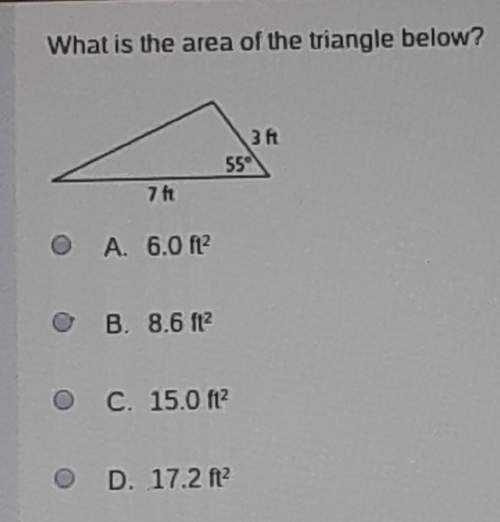
Mathematics, 19.02.2021 17:50 Mtross30
∆ has the coordinates (3, 1), (5, 2), (4, 3). ∆´´´ has coordinates (-1, 2), (1, 3) and (0, 4). Which choice describes the translation of ∆ to ∆´´? A +4 units in the direction of x and -1 units in the direction of y B -4 units in the direction of x and +1 units in the direction of y C +4 units in the direction of x and +1 units in the direction of y D -4 units in the direction of x and -1 units in the direction of y

Answers: 1


Another question on Mathematics

Mathematics, 22.06.2019 00:00
Define the type of sequence below. 7, 14, 28, 56, 112, a. neither arithmetic nor geometric b. arithmetic c. both arithmetic and geometric d. geometric
Answers: 1

Mathematics, 22.06.2019 01:30
Find the vertex for the parabola given by the function ƒ(x) = −3x2 − 6x.
Answers: 2

Mathematics, 22.06.2019 02:20
Of the 27 players trying out for the school basketball team, 8 are more than 6 feet tall and 7 have good aim. what is the probability that the coach would randomly pick a player over 6 feet tall or a player with a good aim? assume that no players over 6 feet tall have good aim. a. b. c. d.
Answers: 1

Mathematics, 22.06.2019 02:30
Which statement best explains whether the table represents a linear or nonlinear function? input (x) output (y) 2 5 4 10 6 15 8 20 it is a linear function because the input values are increasing. it is a nonlinear function because the output values are increasing. it is a linear function because there is a constant rate of change in both the input and output. it is a nonlinear function because there is a constant rate of change in both the input and output.
Answers: 3
You know the right answer?
∆ has the coordinates (3, 1), (5, 2), (4, 3). ∆´´´ has coordinates (-1, 2), (1, 3) and (0, 4). Which...
Questions



Mathematics, 03.07.2019 20:30

Biology, 03.07.2019 20:30

Mathematics, 03.07.2019 20:30

Social Studies, 03.07.2019 20:30



Biology, 03.07.2019 20:30


Physics, 03.07.2019 20:30





History, 03.07.2019 20:30


History, 03.07.2019 20:30


History, 03.07.2019 20:30




 and
and 







